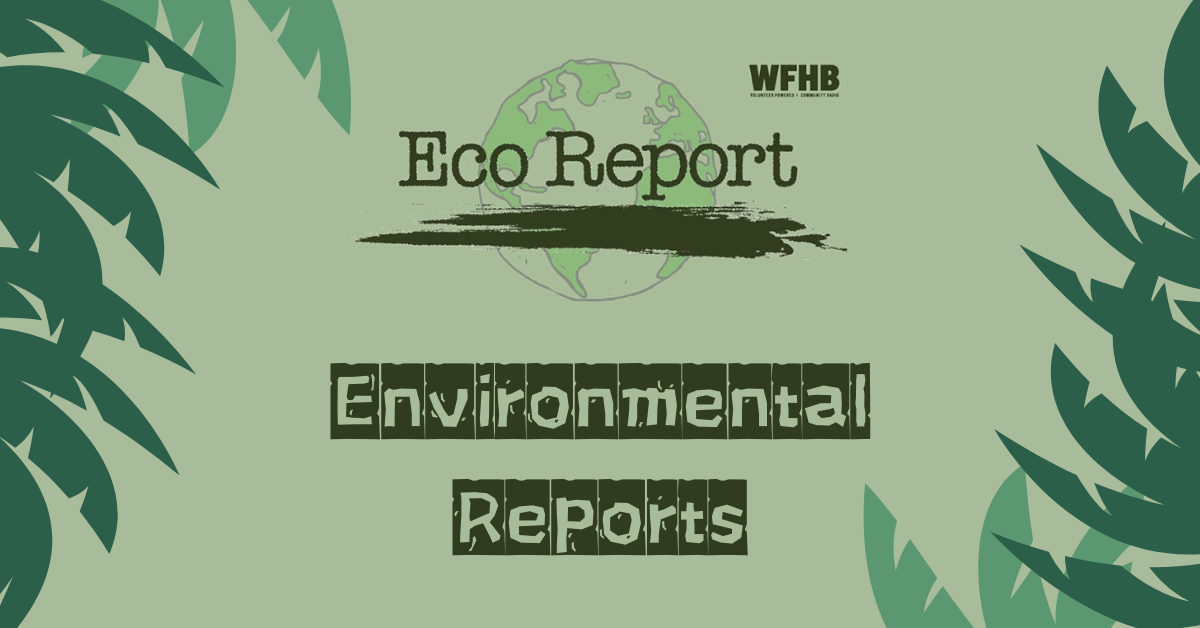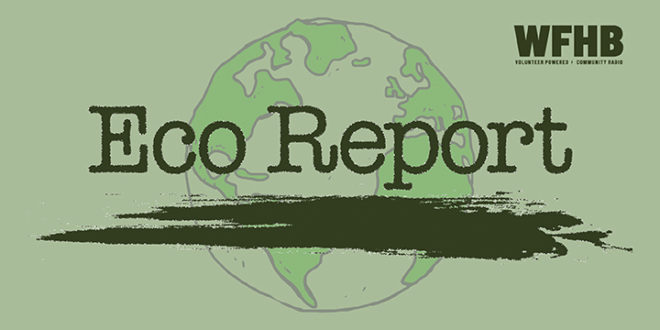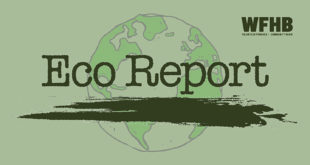Podcast: Play in new window | Download (Duration: 30:11 — 69.1MB)
Subscribe: RSS
In this week’s feature report, WFHB News Correspondents Noelle Herhusky-Schneider, Kade Young and Madison Stratton investigate Indiana’s efforts to rollback protections for wetlands. This is Part Two of a four-part series that previously aired on Deep Dive: WFHB and Limestone Post Investigate.

The New York Times reports new ‘detective work’ on butterfly declines reveals a prime suspect. Agricultural insecticides were a key factor, according to a study focused on the Midwest, though researchers emphasized the importance of climate change and habitat loss. What’s driving ominous declines in insects? Primary concerns are butterflies and bees. While a growing body of research shows decreases in many insect populations, it has been hard for scientists to disentangle the possible causes. Are insects suffering from habitat loss as natural areas are plowed and paved? Is climate change doing them in? What about pesticides?
The latest insight comes from a study on butterflies in the Midwest, published on Thursday in the journal PLOS ONE. Its results don’t discount the serious effects of climate change and habitat loss on butterflies and other insects, but they indicate that agricultural insecticides exerted the biggest impact on the size and diversity of butterfly populations in the Midwest during the study period, 1998 to 2014. Especially detrimental, the researchers found, was a class of widely used insecticides called neonicotinoids that are absorbed into the tissues of plants.
“It’s a story about unintended consequences,” said Scott Swinton, a professor of agricultural economics at Michigan State University and one of the study’s authors. “In developing technologies that were very effective at controlling soybean aphid and certain other agricultural pests, non-target species that we care about, butterflies in particular, have been harmed.”
Farmers in Indiana widely use neonicotinoids on corn and soybeans. This type of pesticide is banned in California, Colorado, Connecticut, Maine, Maryland, Massachusetts, New Jersey, New York, Rhode Island and Vermont. In the EU, neonicotinoids have had restrictions placed on their use, which are as follows: the use in bee-attractive crops (including corn, oilseed rape and sunflower) is prohibited, with the exception of uses in greenhouses.
The attack by the emerald ash borer on ash trees has been underway for more than a decade. Now a question is whether any ash trees will survive. A report from Penn State University has the answer: barely. “Lingering ash.” That’s what the U.S. Forest Service calls the relatively few green and white ash trees that survive the emerald ash borer onslaught. Those trees do not survive by accident, and that may save the species, according to Penn State researchers, who conducted a six-year study of ash decline and mortality.
The research shows some ash trees have varying degrees of resistance to the strangely beautiful, invasive beetle from Asia. The study is unique because it took place at a plantation of ash trees planted on Penn State’s University Park campus in the mid-1970s. “We found that genetic variation exists in trees from around the country, and through time — especially as the emerald ash borer population collapses because host trees are rapidly disappearing — the resistance that we observed will likely ensure the survival of the species,” said Kim Steiner, professor of forest biology, College of Agricultural Sciences.
This little-known ash plantation off Porter Road near Penn State’s Swine Research Facility — the largest collection of green ash germplasm in one location in the world — may play a role in saving the species. “We began measuring the decline in 2012, shortly after emerald ash borers arrived in the plantation, and we measured it every year through 2017,” said Steiner. “The effect of the insect was devastating. As of August of this year, only 13 trees remained of the 1,762 that were alive when the emerald ash borer arrived.”
The fact that some trees survived longer means there are heritable genetic differences among trees from different populations and seed parents, Steiner added. “For the first time, this study demonstrated that there is genetic variation that could be captured in a breeding program to improve resistance to emerald ash borer in both white ash and green ash species,” he said.
According to the Sierra Club, Duke Energy, the largest electric utility in the state, filed a case with the Indiana Utility Regulatory Commission’s (IURC) requesting to raise residential customers’ bills an additional 19% by 2026. If approved, Duke would use its customers’ money to keep its massively polluting Gibson and Edwardsport coal-burning power plants open.
Extensive evidence in Duke’s previous rate hike case, filed in 2019, showed the Edwardsport coal gasification plant loses money the majority of the time it operates. EcoReport concludes basically this plant has been a boondoggle since inception because Duke could not master the design and operation of the plant. They were amateurs trying to use a process that required experts. EcoReport aired stories years ago, calling for Duke to bring in experts from South Africa.
That nation used the very process as part of the way they made gasoline while there was an embargo on importing gasoline during apartheid. Based on public data, Duke’s Gibson plant lost an estimated $55.6 million in energy market revenues last year, making Gibson the “losingest” coal-burning power plant in an electric wholesale market anywhere in the country in 2023. “For over a decade, Duke has unfairly put the burden on customers’ pocketbooks to prop up its money-losing Edwardsport and Gibson plants.
Instead of investing in clean and affordable renewable energy, Duke energy chose to waste billions of our hard earned dollars,” said Robyn Skuya-Boss, Hoosier Chapter Sierra Club Director. “Regulators at the IURC can’t keep allowing Duke to put our money into polluting resources; we need to see investments in clean energy that benefit our communities.”
Across the state, Duke is the largest utility polluter, and furthest behind in building clean energy. The monopoly utility’s Gibson plant in Southwest Indiana was identified by the Center for Public Integrity as a Super Polluter, one of the worst toxic and greenhouse gas emitters in the nation. Burning coal at this plant alone contributes to 78 premature deaths annually.
Duke’s Gibson plant has become an even worse investment for ratepayers since the company’s last rate case filing because its electric generation is uncompetitive in today’s grid. In 2023, Gibson had its lowest output ever. Nonetheless, due to low market prices and rocketing coal costs, Duke operated Gibson far more often than warranted, at a steep cost to consumers.
Sierra Club will further scrutinize the filing, which contains thousands of pages, and will be encouraging community members to speak out against the rate hike by submitting public comments to regulators over the coming months. There was a public meeting recently on Duke’s proposal. Our reporting on this meeting is separate from this review. In the information note sent to community activists, there was important information which is repeated here. EcoReport has not independently evaluated the recommendations.
RCU has been running a Follow the Money Campaign on three state house seats with voters partly in Monroe County. Not one of them is voting for consumers or the environment. Citizens Action Coalition indicates Rep. Peggy Mayfield in H60 and Rep. Bob Heaton H46 and Rep. Dave Hall H62 are the legislators of relevance. It’s become clear we will never get voters back into the driver’s seat until we re-balance our General Assembly.
EcoReport will add that Rep. Heaton was involved in making Indiana the worst state for rooftop solar, according to IndyStar. RCU says you have a choice this fall. These are the candidates who deserve your time and your treasure: Michelle Higgs for H60; Kurtis Cummings, H46; and Thomas Horrocks, H62.

In this week’s feature report, WFHB News Correspondents Noelle Herhusky-Schneider, Kade Young and Madison Stratton investigate Indiana’s efforts to rollback protections for wetlands. This is Part Two of a four-part series that previously aired on Deep Dive: WFHB and Limestone Post Investigate.

- A program on boater safety, Canoe Find It? is scheduled for Saturday, June 29th, at Griffy Lake Nature Preserve from 4 to 6 pm. After discussing boater safety, you will head to the water to practice paddling techniques. A scavenger hunt will allow you to practice as well as have fun. There is a prize! Register at bloomington.IN.gov/parks.
- A presentation on Feathered Fledglings is taking place on Tuesday, July 2nd, from 2 to 2:30 pm at McCormick’s Creek State Park. Learn about a bird’s life cycle and when it is okay to help a fledgling. Meet at the Nature Center.
- Wild Wednesday’s at Goose Pond Fish and Wildlife Area will continue on Wednesday, July 3rd, from 10 to 11 am. Take short hikes outside the Visitor Center and learn about Indiana’s wetlands, critters and more.
- Learn about American’s Bird – the Bald Eagle at the Paynetown State Recreation Area at Monroe Lake on Thursday, July 4th, from 2 to 2:30 pm. Find out why they are extra-special and get tips on where to find them. Meet at the Activity Center Patio.
- Learn about Nature’s Fireworks – the Firefly at the Paynetown State Recreation Area at Monroe Lake on Thursday, July 4th, beginning at 8 pm. Discover how these light shows are used by fireflies to attract a mate or a meal. Meet at the Activity Center.
Credits:
On Air………………………………….Julianna Dailey
On Air………………………………….Cynthia Roberts
Headlines……………………………………Norm Holy
Feature Report………….Noelle Herhusky-Schneider
Feature Report…………………………….Kade Young
Feature Report……………………..Madison Stratton
Feature Report……………………………….Zyro Roze
Script……………………………………Julianna Dailey
Events Calendar……………………….Julianna Dailey
Engineer……………………………..Branden Blewett
Are you looking for a way to make a difference on environmental issues?
Eco Report is looking for reporters, engineers, and segment producer to report facts on how we’re all affected by global climate disruption and the ongoing assaults on our air, land and water. We also celebrate ecologists, tree huggers, soil builders and other champions who actively protect and restore our natural world, particularly those who are active in south central Indiana. All levels of experience and all ages are welcome, and we provide the training you’ll need. WFHB also offers internships. To volunteer for Eco Report, call at (812) 323-1200, or e-mail [email protected].
 WFHB Bloomington Community Radio
WFHB Bloomington Community Radio


